Related Research Articles

Alger Hiss was an American government official accused in 1948 of having spied for the Soviet Union in the 1930s. Statutes of limitations had expired for espionage, but he was convicted of perjury in connection with this charge in 1950. Before the trial Hiss was involved in the establishment of the United Nations, both as a U.S. State Department official and as a U.N. official. In later life he worked as a lecturer and author.

Whittaker Chambers was an American writer-editor, who, after early years as a Communist Party member (1925) and Soviet spy (1932–1938), defected from the Soviet underground (1938), worked for Time magazine (1939–1948), and then testified about the Ware Group in what became the Hiss case for perjury (1949–1950), often referred to as the trial of the century, all described in his 1952 memoir Witness. Afterwards, he worked as a senior editor at National Review (1957–1959). US President Ronald Reagan awarded him the Presidential Medal of Freedom posthumously in 1984.

Homer Samuel Ferguson was an American attorney, professor, judge, United States senator from Michigan, Ambassador to the Philippines, and later a Judge on the United States Court of Military Appeals.
Donald Hiss, also known as "Donie" and "Donnie", was the younger brother of Alger Hiss. Donald Hiss's name was mentioned during the 1948 hearings wherein his more famous and older brother, Alger, was accused of spying for the Soviet Union, and two years later convicted of perjury before the House Un-American Activities Committee (HUAC).
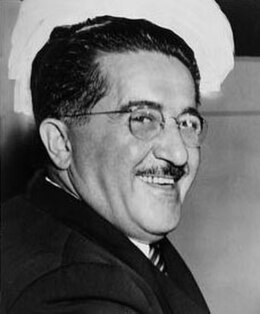
J. Peters was the most commonly known pseudonym of a man who last went by the name "Alexander Stevens" in 1949. Peters was a journalist, political activist, and accussed soviet spy who was a leading figure of the Hungarian language section of the Communist Party USA in the 1920s and 1930s. From the early 1930s, Peters was actively involved in the espionage activities of the Soviet Union in the United States, fabricating passports, recruiting agents, and accumulating and passing along confidential and secret information.
Julian Wadleigh (1904–1994) was an American economist and a Department of State official in the 1930s and 1940s. He was a key witness in the Alger Hiss trials.
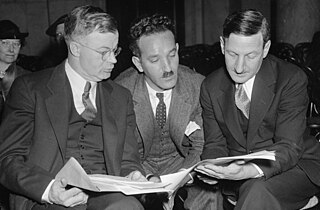
Nathan Witt, born Nathan Wittowsky, was an American lawyer who is best known as being the Secretary of the National Labor Relations Board (NLRB) from 1937 to 1940. He resigned from the NLRB after his communist political beliefs were exposed and he was accused of manipulating the Board's policies to favor his own political leanings. He was also investigated several times in the late 1940s and 1950s for being a spy for the Soviet Union in the 1930s. No evidence of espionage was ever found.
Headed by Victor Perlo, the Perlo group is the name given to a group of Americans who provided information which was given to Soviet intelligence agencies; it was active during the World War II period, until the entire group was exposed to the FBI by the defection of Elizabeth Bentley.
Frederick George Fisher Jr. was an American lawyer who first entered the public eye in connection with Senator Joseph McCarthy.

Louis Francis Budenz was an American activist and writer, as well as a Soviet espionage agent and head of the Buben group of spies. He began as a labor activist and became a member of the Communist Party USA. In 1945, Budenz renounced Communism and became a vocal anti-Communist, appearing as an expert witness at governmental hearings and writing about his experiences.
The Ware Group was a covert organization of Communist Party USA operatives within the United States government in the 1930s, run first by Harold Ware (1889–1935) and then by Whittaker Chambers (1901–1961) after Ware's accidental death on August 13, 1935.
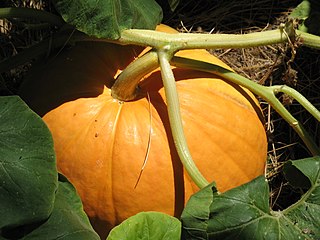
The Pumpkin Papers are a set of typewritten, handwritten, and microfilmed documents, stolen from the US federal government by members of the Ware Group and other Soviet spy networks in Washington, DC, during 1937-1938, withheld by courier Whittaker Chambers from delivery to the Soviets as protection when he defected. The Pumpkin Papers featured frequently in criminal proceedings against Alger Hiss during the period of Hiss Case. The term "Pumpkin Papers" quickly became shorthand for the complete set of handwritten, typewritten, and microfilmed documents in newspapers. Along with names like Richard Nixon, Alger Hiss, and Whittaker Chambers, the Pumpkin Papers is a name closely associated with the Hiss Case.
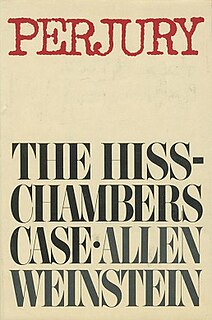
Perjury: The Hiss–Chambers Case is a 1978 book by Allen Weinstein on the Alger Hiss perjury case. The book, in which Weinstein argues that Alger Hiss was guilty, has been cited by many historians as the "most important" and the "most thorough and convincing" book on the Hiss–Chambers case. Weinstein drew upon 30,000 pages of FBI documents released through the Freedom of Information Act, the files of the Hiss defense attorneys, over 80 interviews with involved parties and six interviews with Hiss himself. In 1997, Weinstein published an updated and revised edition of Perjury, which incorporated recent evidence from Venona project decrypted cables, released documents from Soviet intelligence archives and information from former Soviet intelligence operatives.

The House Committee on Un-American Activities (HCUA), popularly dubbed the House Un-American Activities Committee (HUAC), was an investigative committee of the United States House of Representatives, created in 1938 to investigate alleged disloyalty and subversive activities on the part of private citizens, public employees, and those organizations suspected of having either fascist or communist ties. It became a standing (permanent) committee in 1945, and from 1969 onwards it was known as the House Committee on Internal Security. When the House abolished the committee in 1975, its functions were transferred to the House Judiciary Committee.
Bertrand Albert Andrews Jr. was a Washington-based reporter for the New York Herald Tribune who won the Pulitzer Prize in 1948 for his article "A State Department Security Case."
Esther Shemitz, also known as "Esther Chambers" and "Mrs. Whittaker Chambers," was an American painter and illustrator who, as wife of ex-Soviet spy Whittaker Chambers, provided testimony that "helped substantiate" her husband's allegations during the Hiss Case.
Nathan Levine was an American labor lawyer and real estate attorney in Brooklyn, New York, who, as attorney for his uncle, Whittaker Chambers, testified regarding his uncle's "life preserver." This packet included papers handwritten by Alger Hiss and Harry Dexter White, as well as typewritten by the Hiss Family's Woodstock typewriter. It also included microfilm, paraded to the public by U.S. Representative Richard M. Nixon and HUAC investigator Robert E. Stripling, dubbed the "Pumpkin Papers" by the press, which helped lead to the U.S. Department of Justice to indict Hiss for perjury.
Robert E. Stripling was a 20th-century civil servant, best known as chief investigator of the House Dies Committee and its successor the House Un-American Activities Committee (HUAC), particularly for collaboration with junior congressman Richard Nixon and for testimony gleaned from witness Elizabeth Bentley and Whittaker Chambers, the latter of whose allegations led indirectly to indictment and conviction of State Department official Alger Hiss in January 1950.
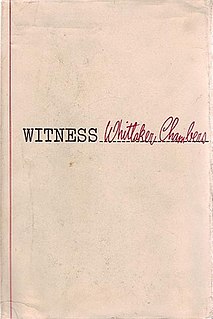
Witness, first published in May 1952, is a best-selling book of memoirs by American writer Whittaker Chambers (1901-1961), which recounts his life as a dedicated Marxist-communist ideologist in the 1920s, his work in the Soviet underground during the 1930s, and his 1948 testimony before the US Congress, which led to a criminal indictment against Alger Hiss and two trials in 1949.
References
- ↑ Butterfield, Fox (May 6, 1984). "TV Plays the Hiss Case Down the Middle". The New York Times . Retrieved January 29, 2017.
- ↑ Hastings, Julianne (May 3, 1984). "Hiss-Chambers spy tale told in PBS'S 'Concealed Enemies'". upi.com. Retrieved January 29, 2017.
- ↑ Roberts, Jerry (2009). Encyclopedia of Television Film Directors. Scarecrow Press. p. 47. ISBN 9780810863781.
- ↑ Chambers, Whittaker (May 1952). Witness . New York: Random House. pp. 799 (total).
- ↑ "Hiss-Chambers Hearing". C-SPAN. 25 August 1948. Retrieved 21 January 2018.
- ↑ "'ENEMIES FROM WITHIN' SPEECH Senator Joseph McCarthy's 1950 Lincoln Day Address by Senator Joseph McCarthy". Highline Public Schools. Retrieved 12 October 2022.
- ↑ Eberts, Jake; Illott, Terry (1990). My indecision is final. Faber and Faber. p. 657.